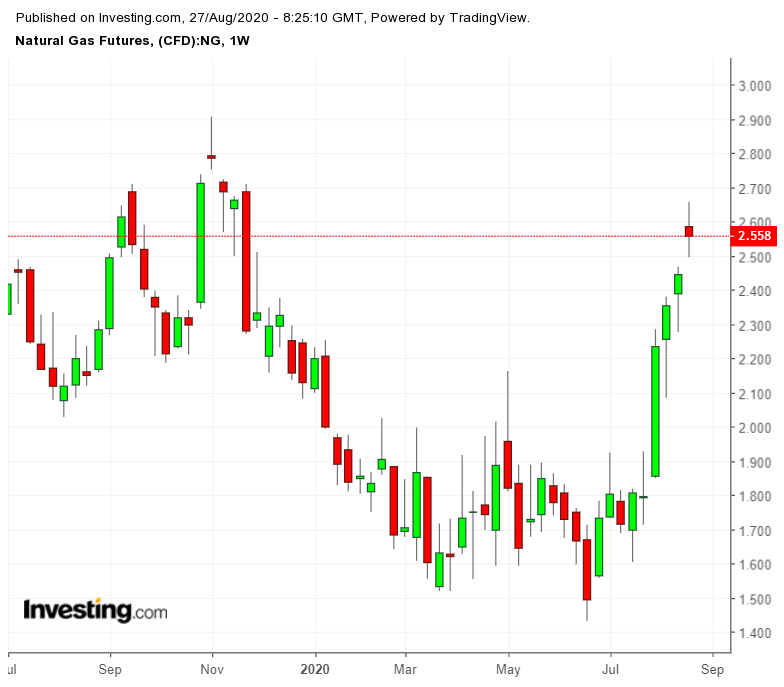Natural gas bulls are having their best winning streak since May as a steady blast of mid-summer heat forces Americans to crank up their air-conditioning, resulting in more gas burns by utilities. Despite that, spot prices of the fuel have stubbornly stayed at the mid-$2 levels.
That could change in the next fortnight based on the potential damage Hurricane Laura may inflict on gas production, processing and export facilities in Texas. While few expect the $3 level reserved for the 2020/21 winter months, some premium is certainly being envisaged from the shut-ins that have now paralyzed almost all gas production in the Lone Star State.
With the potential for disruptions at Sabine Pipe Line LLC’s Henry Hub looking increasingly likely, there could be significant implications for trading activity, energy intelligence firm Genscape said in a blog post by naturalgasintel.com.
“After Hurricane Rita in 2005, Henry Hub was flooded for almost two weeks during which there were no flows or physical deals, and therefore no official physical index for price settlements," Genscape analyst Preston Fussee-Durham was quoted saying in the post.
Rita’s track is considered one of the best analogs with respect to Laura’s storm path trajectory as of Wednesday, Fussee-Durham said.
Laura Triggers Widespread Force Majeure In Gas
Sabine Pipe Line also declared a force majeure ahead of Hurricane Gustav in 2008. While this event was short-lived and only lasted for a single day, “it further suggests Laura could impact Henry Hub’s ability to continue operations,” the Genscape analyst stated.
As of Wednesday afternoon, there were no operational notices listed for Sabine Pipe Line.
That’s not all. Cheniere Energy (NYSE:LNG) temporarily suspended operations at the Sabine Pass, LA, terminal, and Cameron LNG on Wednesday implemented a controlled shutdown of its terminal.
“Although operations at both terminals should be able to resume relatively quickly once the storm passes, there is plenty of uncertainty caused by the threat of major hurricane force winds and a 10-15 foot storm surge,” Daniel Myers, analyst at Houston-based gas risk consultancy Gelber & Associates, said in an email to the company’s clients, sighted by Investing.com.
Some Long-Term Delays Expected In Restart Of Facilities
Scott Shelton, energy futures broker at ICAP in Durham, North Carolina, had a similar view, which he expressed in a separate email to Investing.com.
“I think there is some worry that there could be longer term delays at Sabine due to storm issues.”
Cameron Interstate Pipeline LLC, which feeds Cameron LNG, issued a systemwide operational flow order (OFO) indicating that operating conditions were in “critical mode.” Shippers were directed to reduce upstream receipts to the elapsed prorated scheduled quantity, and the OFO was to remain in effect until further notice.
Others like the Creole Trail, Golden Pass, Golden Triangle, Natural Gas Pipeline Co. of America and Tennessee Gas Pipeline systems all declared force majeure and curtailed nominations or service by some margin.
Investing.com’s own data compiled from the Bureau of Safety and Environmental Enforcement and 45 other company reports show that at least 60% of natural gas production in the Gulf of Mexico has been shut ahead of the storm which has hit southwestern coastal Louisiana and the Texas border with a ferocity the region has never endured.
“After the storm has passed, facilities will be inspected,” Dominick Chirichella, director of risk and trading at the Energy Management Institute in New York, said in an email to Investing.com.
“Once all standard checks have been completed, production from undamaged facilities will be brought back online immediately. Facilities sustaining any damage may take longer to bring back on-line.”
Difficult To Quantify Premium From Laura
The problem, however, is the difficulty in quantifying the exact premium natural gas would command from any Laura-related damage.
At Wednesday’s settlement, the most-active gas futures contract on the NYMEX’s Henry Hub, October, settled down 2.2 cents at $2.574 per million metric British thermal units, or mmBtu.
For the week, though, October gas was up 3%, adding to the near 34% gain accumulated in three previous weeks. The four straight positive weeks have been Henry Hub’s best since a similar run between April 12 and May 2019. But that previous stretch produced just over 5% in gains.
With disruptions to supply, October gas on Henry Hub could trade at between $2.70 and $2.80 per mmBtu.
It’s a premium that’s admittedly narrow, and here’s the reason: Analysts at EBW told naturalgasintel.com that despite an expected loss of 3 bcf a day of supply due to the storm, “a week from now, however, the impact on gas prices is likely to be minimal."
Similarly, Tudor, Pickering, Holt & Co analysts said they viewed the short-term impact from the storm to be “a relatively minor blip from a macro perspective.”
Even with widespread power outages, a decline in weather-driven demand and a holiday around the corner, the beginning of September may bring surprises to LNG exports and/or production, analysts at EBW added. LNG feed gas demand “has exhibited fealty to the calendar,” with sharp declines on June 1 and July 1, and a sharp uptick beginning Aug. 1.
The EBW analysts added:
“A similar surprise on September 1 could create further volatility for NYMEX futures."
Thin Weekly Supply Injections Add To Market’s Support
The current bounty in gas prices coincides with eight straight weeks of gas injections into storage that have underwhelmed inventories, boosting the market’s fundamentals from a supply perspective. Since a 120 billion-cubic-feet injection during the week ended June 19, there has not been a triple-digit addition to weekly supply.
This shows that despite the coronavirus pandemic’s purported negative impact on energy demand, utilities were burning more of the gas that they were drawing out of the ground then putting away for later use. For the latest week to Aug. 21, analysts expect gas storage data due from the Energy Information to be at 47 billion cubic feet, versus the 43 bcf reported during the previous week to Aug. 14.

